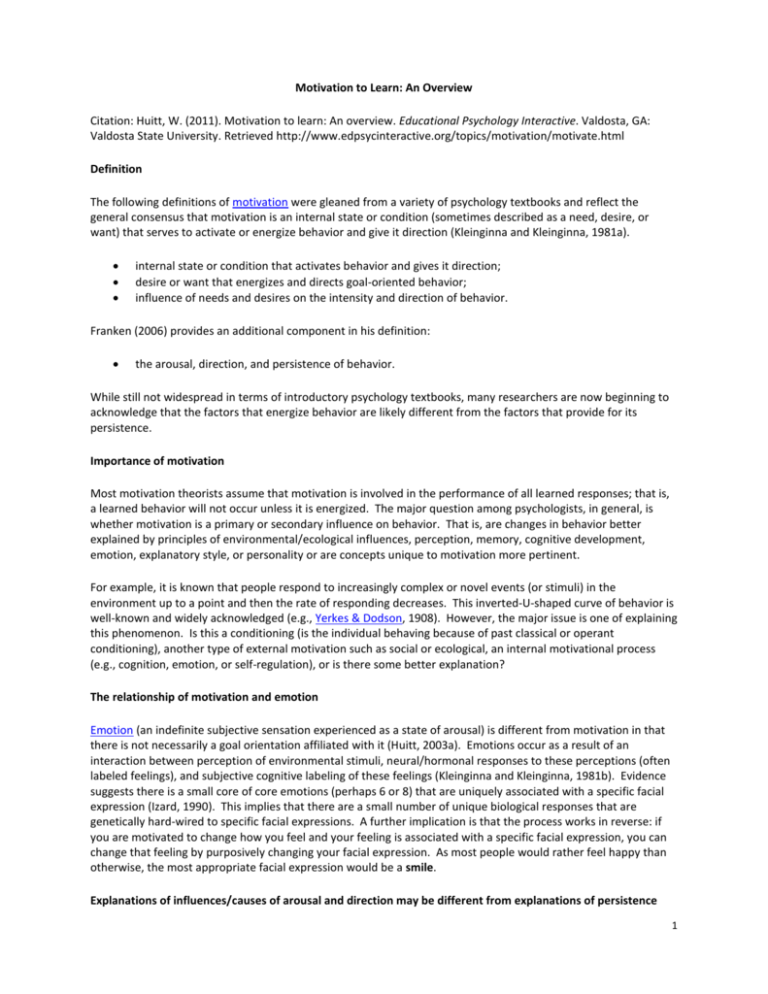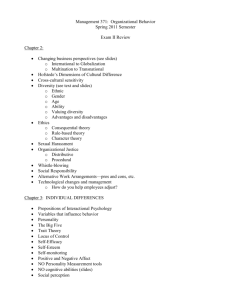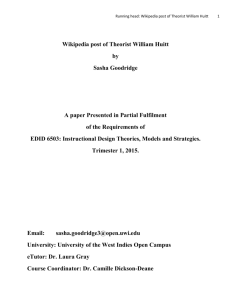Motivation to learn: An overview. Educational Psychology Interactiv
advertisement

Motivation to Learn: An Overview Citation: Huitt, W. (2011). Motivation to learn: An overview. Educational Psychology Interactive. Valdosta, GA: Valdosta State University. Retrieved http://www.edpsycinteractive.org/topics/motivation/motivate.html Definition The following definitions of motivation were gleaned from a variety of psychology textbooks and reflect the general consensus that motivation is an internal state or condition (sometimes described as a need, desire, or want) that serves to activate or energize behavior and give it direction (Kleinginna and Kleinginna, 1981a). internal state or condition that activates behavior and gives it direction; desire or want that energizes and directs goal-oriented behavior; influence of needs and desires on the intensity and direction of behavior. Franken (2006) provides an additional component in his definition: the arousal, direction, and persistence of behavior. While still not widespread in terms of introductory psychology textbooks, many researchers are now beginning to acknowledge that the factors that energize behavior are likely different from the factors that provide for its persistence. Importance of motivation Most motivation theorists assume that motivation is involved in the performance of all learned responses; that is, a learned behavior will not occur unless it is energized. The major question among psychologists, in general, is whether motivation is a primary or secondary influence on behavior. That is, are changes in behavior better explained by principles of environmental/ecological influences, perception, memory, cognitive development, emotion, explanatory style, or personality or are concepts unique to motivation more pertinent. For example, it is known that people respond to increasingly complex or novel events (or stimuli) in the environment up to a point and then the rate of responding decreases. This inverted-U-shaped curve of behavior is well-known and widely acknowledged (e.g., Yerkes & Dodson, 1908). However, the major issue is one of explaining this phenomenon. Is this a conditioning (is the individual behaving because of past classical or operant conditioning), another type of external motivation such as social or ecological, an internal motivational process (e.g., cognition, emotion, or self-regulation), or is there some better explanation? The relationship of motivation and emotion Emotion (an indefinite subjective sensation experienced as a state of arousal) is different from motivation in that there is not necessarily a goal orientation affiliated with it (Huitt, 2003a). Emotions occur as a result of an interaction between perception of environmental stimuli, neural/hormonal responses to these perceptions (often labeled feelings), and subjective cognitive labeling of these feelings (Kleinginna and Kleinginna, 1981b). Evidence suggests there is a small core of core emotions (perhaps 6 or 8) that are uniquely associated with a specific facial expression (Izard, 1990). This implies that there are a small number of unique biological responses that are genetically hard-wired to specific facial expressions. A further implication is that the process works in reverse: if you are motivated to change how you feel and your feeling is associated with a specific facial expression, you can change that feeling by purposively changing your facial expression. As most people would rather feel happy than otherwise, the most appropriate facial expression would be a smile. Explanations of influences/causes of arousal and direction may be different from explanations of persistence 1 In general, explanations regarding the source(s) of motivation can be categorized as either extrinsic (outside the person) or intrinsic (internal to the person). Intrinsic sources and corresponding theories can be further subcategorized as either body/physical, mind/mental (i.e., cognitive/thinking, affective/emotional, conative/volitional) or transpersonal/spiritual. In current literature, needs are now viewed as dispositions toward action (i.e., they create a condition that is predisposed towards taking action or making a change and moving in a certain direction; Franken, 2006). Action or overt behavior may be initiated by either positive or negative incentives or a combination of both. The following chart provides a brief overview of the different sources of motivation (internal state) that have been studied. While initiation of action can be traced to each of these domains, it appears likely that initiation of behavior may be more related to emotions and/or the affective area (optimism vs. pessimism; self- esteem; etc.) while persistence may be more related to conation (volition) or goal-orientation. Sources of Motivational Needs behavioral/external social biological cognitive elicited by stimulus associated/connected to innately connected stimulus obtain desired, pleasant consequences (rewards) or escape/avoid undesired, unpleasant consequences imitate positive models acquire effective social competence skills be a part of a dyad, group, institution, or community increase/decrease stimulation (arousal) activate senses (taste, touch, smell, etc. decrease hunger, thirst, discomfort, etc. maintain homeostasis, balance maintain attention to something interesting or threatening develop meaning or understanding increase/decrease cognitive disequilibrium; uncertainty solve a problem or make a decision 2 affective conative spiritual figure something out eliminate threat or risk increase/decrease affective dissonance increase feeling good decrease feeling bad increase security of or decrease threats to self-esteem maintain levels of optimism and enthusiasm meet individually developed/selected goal obtain personal dream develop or maintain self-efficacy take control of one's life eliminate threats to meeting goal, obtaining dream reduce others' control of one's life understand purpose of one's life connect self to ultimate unknowns Theories of motivation Many of the theories of motivation address issues introduced previously in these materials. The following provides a brief overview to any terms or concepts that have not been previously discussed. Behavioral Each of the major theoretical approaches in behavioral learning theory posits a primary factor in motivation. Classical conditioning states that biological responses to associated stimuli energize and direct behavior (Huitt & Hummel, 1997a). Operant learning states the primary factor is consequences: the application of reinforcers provides incentives to increase behavior; the application of punishers provides disincentives that result in a decrease in behavior (Huitt & Hummel, 1997b). Cognitive There are several motivational theories that trace their roots to the information processing approach to learning (Huitt, 2003b). These approaches focus on the categories and labels people use to help identify thoughts, emotions, dispositions, and behaviors. One cognitive approach is attribution theory (Heider, 1958; Weiner, 1974). This theory proposes that every individual tries to explain success or failure of self and others by offering certain "attributions." These attributions are either internal or external and are either under control or not under control. The following chart shows the four attributions that result from a combination of internal or external locus of control and whether or not control is possible. Internal External No Control Ability Luck Control Effort Task Difficulty 3 In a teaching/learning environment, it is important to assist the learner to develop a self-attribution explanation of effort (internal, control). If the person has an attribution of ability (internal, no control) as soon as the individual experiences some difficulties in the learning process, he or she will decrease appropriate learning behavior (e.g., I'm not good at this). If the person has an external attribution, then the person will have a believe that nothing the person can do will help that individual in a learning situation (i.e., responsibility for demonstrating what has been learned is completely outside the person). In this case, there is nothing to be done by the individual when learning problems occur. A second cognitive approach is expectancy theory (Vroom, 1964) which proposes the following equation: Motivation = Perceived Probability of Success (Expectancy) * Connection of Success and Reward (Instrumentality) * Value of Obtaining Goal (Valance, Value) Since this formula states that the three factors of Expectancy, Instrumentality, and Valance or Value are to be multiplied by each other, a low value in one will result in a low value of motivation. Therefore, all three must be present in relatively high levels in order for motivation to occur. That is, if an individual does not believe he or she can be successful at a task OR the individual does not see a connection between his or her activity and success OR the individual does not value the results of success, then the probability is lowered that the individual will engage in the required learning activity. From the perspective of this theory, all three variables must be high in order for motivation and the resulting behavior to be high. The third cognitive approach is cognitive dissonance theory which is in some respects similar to disequilibrium in Piaget's theory of cognitive development (Huitt & Hummel, 2003). This theory was developed by Leon Festinger (1957), as social psychologist, and states that when there is a discrepancy between two beliefs, two actions, or between a belief and an action, individuals will act to resolve conflict and discrepancies. The implication is that if an appropriate amount of disequilibrium is created, this will in turn lead to the individual changing his or her behavior which in turn will lead to a change in thought patterns which in turn leads to more change in behavior. Summary To summarize the cognitive approaches, notice the relationship between William James' (as cited in Huitt, 2009) formula for self-esteem (Self-esteem = Success / Pretensions) and the attribution and expectancy theories of motivation. If a person has an external attribution of success, self-concept is not likely to change as a result of success or failure because the person will attribute it to external factors. Likewise, if the person has an Internal/Ability explanation, his or her self-concept will be tied to learning to do a new activity quickly and easily (I do well because I am naturally good at it). If failure or difficulty occurs, the person must quickly lower expectations in order to maintain self-esteem. However, if the person has a Internal/Effort explanation and high expectations for success, the person will persevere (i.e., stay motivated) in spite of temporary setbacks because one's selfesteem is not tied to immediate success. On the other hand, cognitive dissonance theory suggests that individuals will seek balance or dynamic homeostasis in one's life and will resist influences or expectations to change. How, then, does change or growth occur. One source, according to Piaget, is biological development. As human beings mature cognitively, thinking processes and organizations of knowledge (e.g., schemas, paradigms, explanations) are reworked to more accurately reflect one's understanding of the world. One of those organizations involves explanations or attributions of success or failure. After puberty, when biological change slows down considerably, it is very difficult to change these attributions. It requires a long-term program where constant feedback is provided about how one's behavior is responsible for one's success. 4







